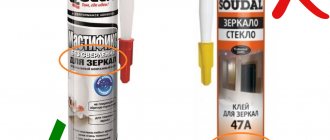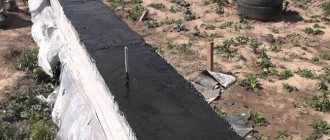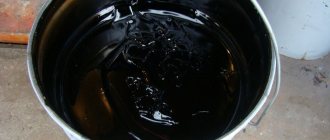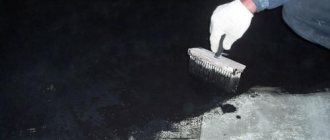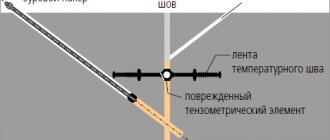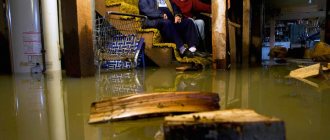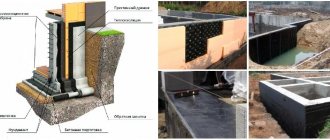Waterproofing with liquid glass - technology for any surface
The industry produces several varieties of these products. But the most widely used, especially in construction, are potassium or sodium silicates, aqueous (alkaline) solutions of which are called liquid glass (LG). This material is used for various purposes, but we will focus on only one type of work - waterproofing, i.e. protection of structures from exposure to liquids. In principle, in order to equip a waterproofing layer, there are many different products. Mastic, roll, film and a number of others. They all have their own characteristics and specific applications. But the method of working with “liquid” glass is so simple that it does not pose any difficulty even for an inexperienced person, does not require special training, and these products can be used under almost any conditions.
- Advantages of “liquid” glass
- Technology
- Surface preparation
- Coating
- Penetrating
How to properly prepare concrete mortar with liquid glass
To prepare such a batch, follow these steps:
- Take a bucket of clean drinking water (without salts or other impurities). Process water cannot be used, as the inclusions contained in it may affect the reaction.
- Pour a glass of liquid glass into the water and stir the mixture thoroughly until the silicate glue is completely dissolved.
- Pour the resulting liquid into a trough or basin.
- While stirring the liquid, add concrete and sand to it in the required proportion.
- Beat the concrete solution using a construction mixer or a drill with an attachment until a homogeneous mass is obtained.
- Pour concrete into the formwork.
When preparing the solution, it is important to consider the following recommendations:
- Under no circumstances should soluble glass be added to a cement-sand mixture without first dissolving the additive in water. The same applies to water - it can be added to the mixture only after it has been mixed with glue.
- Most packages with liquid glass have instructions that if you add a foundation additive (as described above), then you need to use no more than 3% silicate glue; in all other cases, follow the information from the manufacturer.
- Since the additive significantly reduces the hardening time of concrete, it is better to prepare the solution in small portions. If you use a concrete mixer for this, the mixture will set before mixing is complete. Also keep in mind that you will have to work very quickly.
- After adding silicate glue, you must thoroughly wash all tools and hands.
- Although liquid glass is not toxic, you should not allow silicate glue to splash onto exposed skin or into your eyes. You need to work in a well-ventilated area, away from sources that could create a spark.
Features of application
The feasibility of its use is explained by the following characteristics:
- The ability to apply complex configurations to structures and penetrate into any hard-to-reach places.
- The ability to form a seamless seamless coating , which guarantees 100% protection against moisture infiltration.
- High resistance to constantly damp environments, compared to bituminous materials.
- A thin, light layer of liquid glass can replace several layers of heavy roll waterproofing.
- Liquid glass is safe, non-toxic, non-flammable, and does not melt at high temperatures.
It should also be noted that waterproofing concrete with liquid glass has a positive effect on concrete grades . And the injection of this waterproofing material, coupled with cement, strengthens the foundation for the future building and protects the entire building structure from subsidence.
Let's figure it out, what is the peculiarity of this material?
Advantages and disadvantages
Liquid glass, used as waterproofing, is a thick, viscous and sticky mixture of an aqueous solution of silicates.
Concrete has a porous and loose structure, and when this solution is applied to its surface, all concrete cavities are filled.
There, in the capillaries, the liquid glass dries and turns into crystals.
Thus, a solid waterproof film is created, which, in addition to all that has been said, also creates antiseptic protection .
But is this process good for all situations? Let's look at the waterproofing of concrete with liquid glass from the other side and see that there are also negative aspects to this:
- A material that forms a film on the surface identical to glass, that is, fragile and delicate. This film must be protected with other waterproofing materials.
- The main composition of this building material is a silicate solution of potassium and sodium, which has good adhesive properties, that is, rapid penetration and adhesion. This property requires speed and skill during application.
Technology for waterproofing basements with liquid glass
There are two main ways to use glass to create a water barrier.
In the process of preparing for waterproofing, the concrete surface is cleaned of dirt, degreased, and leveled with plaster mortar. Next, it is treated with liquid glass using a spray gun, brush or roller.
Concentrated glass is diluted with water in a ratio of one to two. The consumption usually ranges from 150 to 300 grams per square, depending on the quality of the base.
The depth of penetration of insulation into the pores when applied in one layer is one to two millimeters. For deep impregnation, you need to apply several layers of the composition, in this case the penetration will be up to two centimeters. When processing, special attention is paid to seams and joints.
The second processing method is to use glass in the concrete solution, one to ten.
Such waterproofing is sufficient for basements, plinths and even for water tanks - ponds, swimming pools. The technology is used to repair serious leaks and can be used on prefabricated foundations of wooden houses. The proportions must be observed carefully to avoid the fragility of the layer, and take into account that the composition dries quickly.
Such waterproofing can be combined with traditional bitumen. The concrete is impregnated with the composition, then the rolled material is placed. It is recommended to apply the glass twice to ensure that the pores are filled.
There is another option, not used often. Treatment with liquid glass of wooden parts of the foundation (for example, pillars) or boards of the internal lining of the basement. The element, previously sanded with emery cloth, is immersed in a solution of liquid glass.
The composition can also be used for anti-corrosion protection of metals - coat pipes with it.
For the processing method described below, you need to purchase soda glass. You will also need tar solution and clay. Procedure:
1. Treat the walls with glass in three layers.
note
Before applying a new layer, you should wait until the previous one has completely dried. Drying usually takes 15 minutes, but this depends on the temperature and humidity in the room.
2. Dilute the clay in water, mix with a concentrated solution of tar until the consistency of thick sour cream.
3. Treat the walls with a layer of 25 centimeters.
4. Dry for two weeks and finish. Before tiling the surface, you need to wait three weeks.
Using liquid glass for foundation waterproofing
There are three options for using liquid glass as a waterproofing material:
- coating waterproofing with silicate solution. In this case, liquid glass is applied in two layers to the surface, which will subsequently be protected by other materials, for example, rolled ones. Part of the solution penetrates into the thickness of the concrete and fills micropores;
- use of mortar on liquid glass and cement. This solution sets very quickly, so it is used mainly for eliminating serious leaks. It can also be used to waterproof the seams of precast foundations;
- the use of liquid glass as an integral part of the concrete mixture. This option allows you to form a monolith, the mass of which, after hardening, will have excellent waterproofing properties. But there is one nuance: it is not easy to independently calculate the exact dosage of liquid glass so that its addition does not affect the strength of the foundation. In addition, concrete, which is sealed with a silicate solution, sets very quickly, so its installation must be carried out in a short time
Advantages and disadvantages of liquid glass
The advantages of this material include: excellent adhesion to mineral substrates; creating an effective waterproof barrier; ease of use; low material consumption; relatively low cost of solutions.
However, liquid glass is not without its drawbacks: limited use for foundation waterproofing (on surfaces accessible for treatment); the need to use liquid glass together with other materials to protect the waterproofing layer from mechanical damage. In addition, liquid glass crystallizes very quickly, which requires certain skill from the person who directly carries out the work on waterproofing the foundation.
Stages of work on waterproofing the foundation with liquid glass
First of all, you need to decide whether the quality of the silicate solution matches those declared by the manufacturer. Therefore, at the first stage, the purity of liquid glass is checked: the solution should not contain any foreign impurities, the liquid should be thick, without lumps. We draw your attention to the fact that this material, provided the packaging is sealed, has a long shelf life, and even when frozen and defrosted, it does not lose its beneficial properties. So, we’ve sorted out the quality, it’s time to get to work:
- We prepare the foundation surface for applying the first waterproofing layer. It’s good if during the preparatory work before pouring the concrete you used a film to waterproof the foundation, then cleaning the surface of the monolith will not require additional effort;
- using a brush, brush, roller or other tool, evenly apply the first layer of liquid glass to the surface;
- after 20-30 minutes we apply the next layer, making sure that there are no “blind” untreated areas left on the foundation;
- We prepare a protective layer of waterproofing: in a small container, mix a solution of cement on liquid glass (1:1), which we immediately apply in a thin layer to the surface of the foundation. Be careful and try to carry out this stage as quickly as possible: re-mixing an already set solution is not allowed;
- already at the next stages you can begin insulating the foundation with materials suitable for your conditions
As you can see, carrying out work on waterproofing a foundation with liquid glass is practically no different from that when using any other coating materials - all the stages are simple and the work can be done with your own hands.
Liquid glass in modern construction
- Liquid penetrating waterproofing. The principle of operation of the ZhS is quite simple. It is based on the astringent properties of the composition, that is, the ability to spontaneously harden, forming an artificial silicate stone. A thickly applied solution with liquid glass for waterproofing is absorbed deep into the concrete and clogs the pores, completely blocking the passage of moisture. To achieve maximum effect, it is advisable to apply the material in two or three layers.
We recommend that
it is recommended to additionally install roll or coating waterproofing on the treated surface.
- Additive for concrete production. These compounds are often used to treat the inner surface of swimming pools or to seal all kinds of low-moving seams. Such solutions set quickly, so the time for its production is limited: it soon becomes unusable.
- Modifier for different grades of concrete. It is extremely important to maintain the correct ratio of components. Only in this case, after setting, a real concrete monolith is obtained, which is distinguished by high waterproofing characteristics. Otherwise, it turns out to be fragile, just like glass. The mixture is prepared directly on the construction site and used immediately.
Application
There are three areas in construction in which this type of glass can be used:
- As a penetrating sealant for cement treated surfaces. What is the point of this use? Several layers are applied to a specific plane. The concrete begins to absorb it, and when it dries, its pores will be clogged. Therefore, moisture cannot penetrate into this base. The use of this building material as independent waterproofing is not particularly effective. It is necessary that the base be covered with additional insulation.
- As an additive in the preparation of cement mixtures. Solutions prepared in this way have the quality of quick drying. But this to some extent narrows the range of applications of such solutions. They are mainly used for plastering the surface of swimming pools and insulating various fixed joints. The prepared mixture must be used quickly; after a very short time, it becomes hard and can no longer be used.
- As a modifier in the production of different types of concrete. Having made the coating with such concrete, it will dry very well and become like a monolith, which has high waterproofing qualities. It is necessary to prepare a solution from such concrete very carefully. If you do not adhere to the required proportions, you will end up with a fragile surface. Such mixtures cool very quickly, so they need to be prepared directly on the spot where they will be immediately used in work.
Cost and reviews
Today, the price of liquid glass is affordable for every person, as it is relatively low.
A canister that holds 15 kg will cost 300 rubles, a 200 liter tank will cost 4,500 rubles. We recommend: Anaerobic sealant for threaded connections in plumbing
If you want to order home delivery, it will cost up to 1000 rubles, which is also not a high fee.
Today, every person who wants to create a high-quality and durable foundation will be able to use liquid glass and enjoy good results.
Review from one buyer:
Blizorukov A.M. “Since I have a country house, I decided to give preference to newfangled additives, and I want to note that I didn’t regret it one bit. I've heard a lot about this option as liquid glass, and now I decided to try it myself. I used liquid glass for the screed and for the foundation, and in both cases I was completely satisfied.
Using this product, I began to notice that the foundation accumulates dust to a lesser extent and practically does not wear off.
Of course, it is worth noting another very important point that such glass is completely fireproof, and this is a big plus. In the future I want to try adding liquid glass to the plaster, I think the effect will be the same. I recommend it to everyone, because the result really makes you rejoice and admire the building.”
Types of waterproofing with liquid glass
There are several ways to perform waterproofing using liquid glass, and each uses a separate technology.
- Coating waterproofing for roll and pasted waterproofing materials;
- Cement-based penetrating waterproofing;
- Monolithic concrete foundation with the addition of liquid glass.
When using liquid glass as a waterproofing material, you should remember the features of sodium silicate:
- Liquid glass dissolves in water, so coating waterproofing of the foundation and pressure hydrostatic load is not reliable, and concrete treated with liquid glass must be additionally protected with rolled materials;
- When adding sodium silicate to cement mortars and concretes, their strength decreases, so the amount of liquid glass in the solution should be no more than 3%;
- The setting time of a solution or concrete with liquid glass is very short, and mixing the solution with the beginning setting process is prohibited, since the process stops. Therefore, it is necessary to prepare the amount of solution that can be used quickly.
Processing concrete with liquid glass
Despite the fact that it is better not to introduce liquid glass into the solution, concrete can be treated with it. For example, you can seal cracks and crevices even if water is leaking from them.
After the liquid glass dries, a dense film forms on the concrete. But it dissolves in water, so it just washes off
Sealing cracks and leaks
Make a very small batch. Even less than with alabaster. No more than 500 grams. The dry components (cement and sand) are mixed and the required amount of liquid glass is added to the liquid. For repair fillings, the quantity is 10% by weight of M400 cement. The quantity is measured strictly on scales. Water and liquid glass are poured into the mixture of dry ingredients and quickly brought to homogeneity.
Making a batch with liquid glass for an instantly hardening filling - yes
The solution is applied very quickly to the damage. From the moment of mixing to the moment the hardening begins, it only takes a few minutes. To be safe, we can assume that it is one minute. You can hold the patch through the film with your hand or support it with something if the area is large. Once set, the patch holds water. To prevent it from crumbling, it is rubbed down with cement. The second option for forming a hard film on the surface is to brush it with a brush dipped in calcium chloride. This creates a hard film. But this is only a temporary solution. Over time, the patch will still fail.
Surface waterproofing
The concrete surface is treated with liquid glass if it is necessary to increase its resistance to water. Then the laid or not completely hardened concrete is simply treated (painted) with a brush dipped in liquid glass. Really helps. A dense and durable film is formed on the surface, but under load it can crack. Therefore, the floor should not be treated this way. You can treat the basement walls, for example. To prevent the film from cracking, you must either apply plaster on top or cover it with something (gypsum plasterboard or OSB or something else).
The use of liquid glass as a temporary solution - treatment of concrete walls
Just keep in mind that after treating the surface with liquid glass, problems with finishing will arise. The paint will not adhere well and the plaster will slide off. Only silicate paint is compatible, and it has a limited number of colors, since silicates do not interact well with pigments.
So liquid glass in concrete, and even as surface waterproofing, is already a thing of the past. Over time, the film either cracks, wears off, or dissolves. There are different types of impregnations and additives with which it is much easier and more reliable to obtain the required properties. And the price isn't that different. So why is it still recommended to add it? But because it was done this way before. They don’t remember exactly how, or maybe they never knew. And I don’t want to deal with new additives. There are many of them, and their properties are different.
How to use glass
How to use glass:
- First, an insulating composition is made by combining glass with cement mortar in a ratio of 1:10.
- The finished composition is used for insulation work in sanitary departments, reservoirs, wells, etc. It can also be used for insulation work with a protective system against ground moisture ingress, by impregnating reinforced concrete parts with the prepared mixture. Do not forget that the mixture sets and hardens quickly, depending on the ambient temperature, the setting period is 1-30 minutes.
- Treatment with a liquid glass composition is carried out in the same way as silicatization. This type of protection allows you to increase the service life of the building many times over. The work itself is not labor-intensive and does not require a lot of effort and money.
Waterproofing with liquid glass
The composition of this glass is an aqueous solution of sodium and potassium; this component is used to perform installation, repair and construction work.
Waterproofing with liquid glass is similar in its properties to any other penetrating waterproofing, therefore the scope of application of this material is similar.
The use of liquid glass for waterproofing is greatest in the treatment of walls, floors of brick and concrete structures, as well as basements.
Antiseptic effect is one of the main features of this building material. The material contains a solution of potassium and sodium silicate with the addition of cement.
Upon contact with the surface, crystals form in sodium, which provide waterproofing properties.
These crystals fill all the pores and cavities of concrete or brick, forming a single surface that can withstand not only moisture, but also the aggressive environments of alkaline elements.
Technology
Glass is divided into sodium and potassium glass, depending on the characteristics of the composition:
- Sodium liquid glass is characterized by its adhesive properties and is able to interact with other mineral substances.
The liquid glass waterproofing technology discussed below has made it possible to use it in waterproofing and strengthening foundations, as well as in the manufacture of antiseptic and fire-resistant impregnations;
- Potassium is distinguished by a high level of resistance to aggressive external influences. This material is also used in the manufacture of all kinds of paints, since, unlike the previous type, it does not create glare.
- When preparing waterproofing material, concrete mortar or cement waterproofing with liquid glass is mixed in a ratio of 10:1. The finished solution can be used as waterproofing for various elements, such as swimming pools, wells or bathrooms. This mixture is also suitable for impregnation of reinforced concrete structures and concrete products or for protecting basements from exposure to a damp environment;
- When treating the surface with building glass, it has the same effect on the material as during silicatization. This treatment increases the service life of the structure several times, while protecting all its surfaces. The processing process in practice turns out to be not so labor-intensive, so do-it-yourself waterproofing with liquid glass is within the capabilities of almost everyone; it will not require any special investment in time or money;
- An important feature of sodium and potassium mortar is its ability to fill all existing small cracks and irregularities. Special substances included in the glass stimulate the appearance of new crystals that fill the entire space. The treated surface is completely covered and impregnated with crystals, due to which there is protection from the adverse effects of water and air on metal and concrete structures.
Typically, this component is diluted with water in the ratio indicated on the packaging before using it.
On average, material consumption is 150-300 g/m2.
When structures or individual products are impregnated with this component, a special protective film is formed on the surface, which restores some areas of the surface of concrete or plaster and provides antistatic protection to the surface.
Liquid glass waterproofing technology:
Application
The positive effects of using liquid glass determine the frequency of its use.
Areas of use:
- There are several types of sodium and potassium solution penetration for surface treatment. Before starting, it is necessary to thoroughly level and degrease the surface. To surface impregnate the building material (plaster layer and concrete) to a depth of 1-2 mm, use a spray gun or brush. To achieve deep impregnation of the material, several layers of solution are applied to the surface, as a result of which it penetrates to a depth of up to 20 millimeters;
- This mixture is used as waterproofing of the basement from the inside with liquid glass and other premises (for example, Stekloizol waterproofing). It is recommended to add cement or concrete mortar to liquid glass for basement waterproofing in the proportions of 1 liter of glass to 10 liters of mortar. Waterproofing of floors with liquid glass, treatment of walls, well ties and other buildings and individual elements are also practiced. This building material has also found its application in anti-corrosion treatment;
- In the production of fire-retardant paints, this solution is used to prevent the ignition of various materials. The supplied set of fire retardant paints consists of two elements that must be mixed only before starting work. From the moment you receive the mixture, fire retardant paint can be used for a maximum of 6-12 hours;
- Waterproofing pools with liquid glass is performed to seal joints or transitions of water pipes, as well as to remove old coating. Liquid glass for pool waterproofing is used to protect the surface from mechanical stress and reliably retain water in the container. This mixture is also used as a universal adhesive for joining various materials;
- Waterproofing the foundation with liquid glass requires compliance with the following technology. It is necessary to prepare the surface of the foundation, then apply the first layer of liquid glass using a roller or brush. After half an hour, apply the next layer. Next, you need to make a 1:1 solution of liquid glass and cement and immediately treat the surface with it. After surface treatment, you can begin external insulation with the selected materials;
Market prices
Liquid glass is an indispensable material for waterproofing and protecting surfaces; due to this material, the service life of the product increases, and the surface is protected.
You can buy liquid glass for waterproofing in a specialized hardware store in your city or in an online catalog.
Also, this building material is sold on the market in departments with construction fluids and repair equipment.
On the market, the price of liquid glass for waterproofing is slightly lower than in specialized stores and averages 50 rubles. per kg.
A more accurate cost depends on the manufacturer, as well as on the amount of consumables you intend to buy. Wholesale purchases are accompanied by discounts.
How much liquid glass to add to concrete: recipes for preparing compositions
Depending on the purpose of using liquid glass, proportions are drawn up. The main thing in this matter is responsibility and accuracy. The universal impregnation recipe provides for a mixture of silicate and water in a ratio of 1:2. There are several options developed by experienced builders that are time-tested.
If a silicate solution is used as a primer, then the mixture is prepared in 1:1 proportions (with cement and adding the required amount of water). That is, add 1 kg of liquid glass to 1 kg of cement and gradually pour in such an amount of water so that the resulting mixture makes it convenient to prime the surface. If the solution hardens quickly, you can add a little water to it after some time.
To waterproof wells, liquid glass is combined with carefully sifted sand in a 1:1 ratio. The resulting mixture is used to cover the walls of the well.
In underground concrete premises, reliable waterproofing will be ensured by adding liquid glass to concrete in the following ratio: 1 liter of silicate glue per 10 liters of cement mortar. This composition guarantees reliable insulation of walls and floors of basements located underground. The refractory mixture is prepared as a cement-sand mortar with the addition of a small amount of liquid glass.
The amount of liquid glass in concrete is calculated depending on the purpose of use
Antiseptic for wood is obtained in this way: mix liquid glass with water in equal proportions. In this case, a slippery protective film is formed on the wood, which cannot be painted. For this reason, this solution is not recommended for use on concrete walls.
Various types of impregnation are prepared, mainly based on the following proportions: 400 ml of liquid glass per 1 liter of water. The next layer is applied after 20-30 minutes - exactly after the same period of time as liquid glass dries on concrete.
Related article:
Water repellents for concrete and brick: modern water-repellent technologies
Basic properties, specific application, their differences. Tips for choosing water-repellent products.
Advantages and disadvantages of the method
Modern technology of using liquid glass for waterproofing has the following advantages:
- formation of a completely waterproof barrier;
- reliable adhesion of the material to the mineral base;
- ease of use;
- low cost of the material itself and low consumption of liquid glass itself.
However, the use of this method also has a number of disadvantages, the main ones being:
- rapid crystallization, due to which independent work is advisable only if you have the appropriate experience. Otherwise, it is better to entrust sealing to professionals;
- the need for additional materials to protect the waterproofing layer.
Advantages and disadvantages of liquid glass for concrete waterproofing
- High level of adhesion. The solution has a fluid consistency, so it completely fills the pores of the surface being treated, thus ensuring reliable adhesion and protection from moisture.
- Creation of a waterproof film. Regardless of the method of processing concrete with liquid glass, the insulating layer is solid. Even its application at temporary intervals does not affect the quality of the insulation.
- Economical consumption of liquid glass for waterproofing. It is worth noting that the consumption is also low when it is added to the cement mixture.
- Convenient price of liquid glass for concrete. It is more affordable than any other modern waterproofing material.
- Antiseptic properties. The resulting solution is not susceptible to mold during operation. In other words, when properly prepared, in addition to reliable waterproofing, it also imparts antiseptic properties to structures.
- Durability. Waterproofing with liquid glass is carried out quite quickly, but lasts a very long time. Its validity period is comparable to the operational life of the house itself.
| Name | Unit | Weight | Volume | Price |
| Sodium wasserglass | Canister (10 l/ 15 kg) | 15 kg | 0.011 m3 | 279 rub. |
cost of liquid glass for waterproofing
Let us note the main disadvantages of waterproofing concrete with liquid glass.
- Fast setting. Although the application technology is quite simple, nevertheless, the high setting speed requires a certain skill and a high pace of work.
- Narrow focus of the use of reinforced concrete for waterproofing. It is used exclusively for moisture protection of surfaces made of concrete or plastered with cement mortar. For example, this method is not suitable for a brick surface.
- Proportions. Liquid glass for waterproofing is added to concrete or cement in precise quantities.
- Combination with other insulating materials. Wasserglass protective film is fragile, so such insulation is often not used independently.

